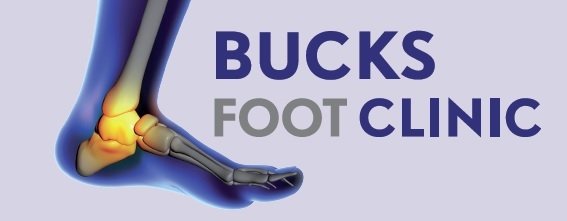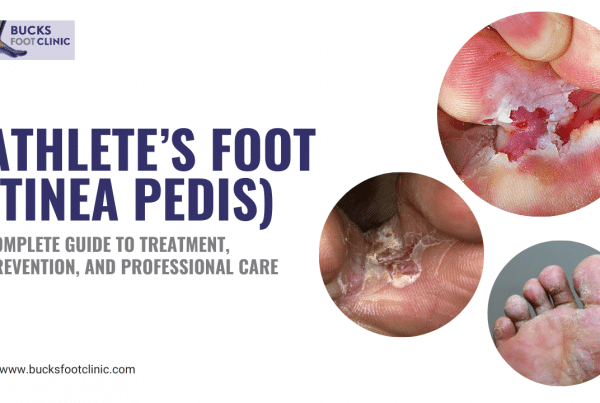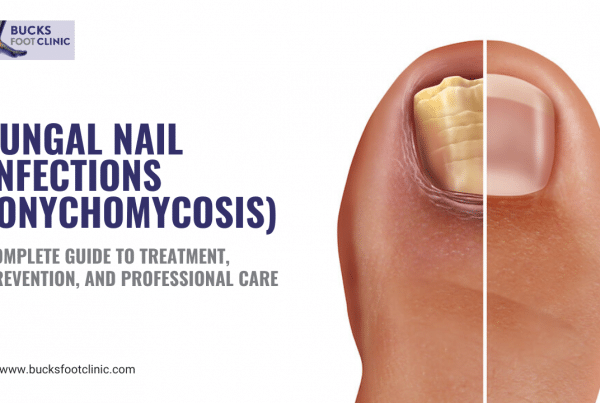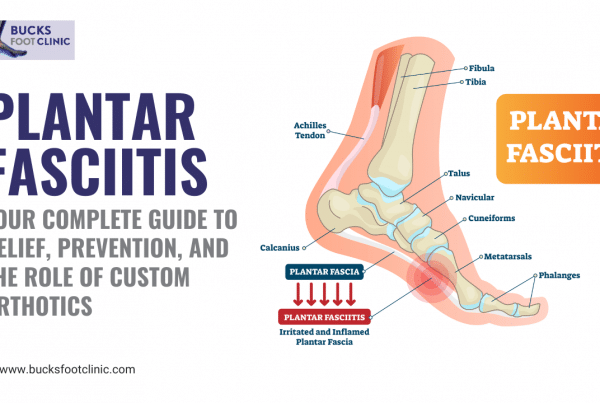
Heel Pain in Adults: Common Causes and Solutions That Actually Work
Are you struggling with persistent heel pain that’s making every step a challenge? You’re not alone. Heel pain affects millions of adults across the UK, transforming simple daily activities like walking to the kitchen or climbing stairs into painful ordeals. If you’re reading this whilst nursing aching heels, you’ve likely tried countless remedies and are desperately seeking answers that actually work.
Understanding the root cause of your heel pain is the first step towards finding lasting relief. At Bucksfootclinic.com, we’ve helped thousands of patients overcome debilitating heel pain and return to active, pain-free lives. This comprehensive guide will explore the most common causes of adult heel pain and provide you with proven solutions that deliver real results.
Understanding Your Heel Pain: Why Every Step Hurts
- Heel pain rarely appears overnight. Most adults experiencing heel pain describe a gradual onset that initially seemed manageable but progressively worsened. Perhaps you first noticed discomfort after a long day on your feet, or maybe the pain struck suddenly after starting a new exercise routine. Regardless of how your heel pain began, the impact on your quality of life is undeniably significant.The heel bone (calcaneus) is the largest bone in your foot and bears the brunt of your body weight with every step. When inflammation, injury, or structural problems affect this area, the resulting pain can be excruciating. Many patients describe their heel pain as a sharp, stabbing sensation that’s particularly severe first thing in the morning or after periods of rest.
Plantar Fasciitis: The Leading Culprit Behind Your Heel Pain
Plantar fasciitis accounts for approximately 80% of heel pain cases in adults. This condition occurs when the plantar fascia—a thick band of tissue connecting your heel bone to your toes—becomes inflamed and irritated. If you’re experiencing sharp, stabbing pain in your heel, particularly during your first steps in the morning, plantar fasciitis is likely the culprit.
The plantar fascia acts as a shock absorber and supports the arch of your foot. When subjected to excessive stress or strain, tiny tears can develop in the tissue, leading to inflammation and pain. Factors that increase your risk of developing plantar fasciitis include:
- Age: Most common between ages 40-60
- Foot mechanics: Flat feet, high arches, or abnormal walking patterns
- Obesity: Extra weight increases stress on the plantar fascia
- Occupational factors: Jobs requiring prolonged standing or walking
- Exercise choices: Activities with high impact on the feet
Understanding that plantar fasciitis is a progressive condition is crucial. Without proper treatment, the pain typically worsens over time, potentially leading to chronic heel pain that significantly impacts your mobility and quality of life.
Other Common Causes of Adult Heel Pain
While plantar fasciitis dominates heel pain diagnoses, several other conditions could be responsible for your discomfort:
Heel Spurs
Heel spurs are bony growths that develop on the underside of the heel bone. Often associated with plantar fasciitis, these calcium deposits can cause significant pain when walking or standing. Many patients with heel spurs describe a sharp, knife-like pain that intensifies with activity.
Achilles Tendinitis
Pain at the back of your heel might indicate Achilles tendinitis. This condition involves inflammation of the Achilles tendon, which connects your calf muscles to your heel bone. The pain typically worsens with activity and may be accompanied by stiffness and swelling.
Bursitis
Heel bursitis occurs when the small, fluid-filled sacs (bursae) that cushion your heel become inflamed. This condition often develops from repetitive activities or prolonged pressure on the heel.
Stress Fractures
Overuse or sudden increases in activity can lead to stress fractures in the heel bone. These tiny cracks cause deep, aching pain that worsens with weight-bearing activities.
Tarsal Tunnel Syndrome
Sometimes called “carpal tunnel of the foot,” this condition involves compression of the tibial nerve as it passes through the tarsal tunnel near your ankle. The resulting pain can radiate into the heel and arch of your foot.
Recognising the Warning Signs: When Heel Pain Requires Professional Attention
Your heel pain isn’t just a minor inconvenience—it’s your body’s way of signalling that something needs attention. Recognising when to seek professional help can prevent your condition from worsening and potentially becoming chronic.
Seek immediate professional consultation if you experience:
- Severe pain that prevents normal walking
- Pain accompanied by numbness or tingling
- Signs of infection (redness, warmth, swelling, fever)
- Pain following a significant injury
- Persistent pain lasting more than a few weeks despite home treatment
Many patients make the mistake of dismissing heel pain as a normal part of ageing or something they must simply endure. This approach often leads to compensatory movement patterns that can cause additional problems in your knees, hips, and back.
Evidence-Based Treatment Solutions for Lasting Heel Pain Relief
Effective heel pain treatment requires a comprehensive approach that addresses both the symptoms and underlying causes. Here are proven treatment strategies that have helped countless patients achieve lasting relief:
Conservative Treatment Approaches
Rest and Activity Modification: The first step in treating heel pain involves identifying and modifying activities that exacerbate your symptoms. This doesn’t mean complete inactivity, but rather strategic rest that allows healing while maintaining overall fitness.
Ice Therapy: Applied correctly, ice can significantly reduce inflammation and pain. Use ice for 15-20 minutes several times daily, particularly after activities that trigger your symptoms.
Stretching and Strengthening Exercises: Specific exercises targeting the plantar fascia, Achilles tendon, and calf muscles can dramatically improve your symptoms. These exercises should be performed consistently and with proper technique for maximum benefit.
Professional Treatment Options
Custom Orthotics: Professional-grade orthotic devices can correct biomechanical imbalances that contribute to heel pain. Unlike over-the-counter inserts, custom orthotics are designed specifically for your foot structure and gait patterns.
Physical Therapy: A structured physical therapy programme can address muscle imbalances, improve flexibility, and teach you proper movement techniques to prevent future episodes of heel pain.
Shockwave Therapy: This innovative treatment uses acoustic waves to stimulate healing in damaged tissues. Many patients experience significant improvement after a series of shockwave therapy sessions.
Injection Therapy: In cases where conservative treatments haven’t provided sufficient relief, targeted injections can reduce inflammation and pain whilst other treatments take effect.
Advanced Treatment Options for Persistent Heel Pain
When conservative treatments don’t provide adequate relief, several advanced options can effectively address stubborn heel pain:
Platelet-Rich Plasma (PRP) Therapy: This cutting-edge treatment uses your body’s own healing factors to promote tissue repair and reduce inflammation.
Minimally Invasive Procedures: Techniques such as percutaneous fasciotomy can release tension in the plantar fascia without the need for traditional surgery.
Surgical Intervention: Reserved for severe cases that don’t respond to conservative treatment, surgical options can provide definitive relief for chronic heel pain sufferers.
Prevention Strategies: Protecting Your Feet from Future Heel Pain
Once you’ve experienced heel pain, preventing recurrence becomes paramount. Implementing these evidence-based prevention strategies can significantly reduce your risk of future episodes:
Proper Footwear Selection: Choose shoes with adequate arch support, cushioning, and a slight heel. Avoid walking barefoot on hard surfaces and replace worn-out shoes promptly.
Weight Management: Maintaining a healthy weight reduces stress on your feet and decreases the likelihood of developing heel pain.
Gradual Activity Progression: When starting new exercise routines or increasing activity levels, do so gradually to allow your feet time to adapt.
Regular Stretching: Incorporate daily stretching routines that target your calves, Achilles tendon, and plantar fascia.
Why Professional Diagnosis Matters for Your Heel Pain
Many adults attempt to self-diagnose and treat their heel pain, often leading to prolonged suffering and potential complications. Professional diagnosis is crucial because:
- Different conditions require different treatment approaches
- What appears to be simple heel pain might indicate a more serious underlying condition
- Early intervention typically leads to better outcomes and faster recovery
- Professional treatment can prevent the development of chronic pain patterns
A qualified podiatrist can perform comprehensive examinations, including gait analysis, imaging studies, and biomechanical assessments to identify the exact cause of your heel pain.
The Cost of Delaying Treatment: Why Waiting Makes Heel Pain Worse
Every day you delay addressing your heel pain, you risk:
- Chronic Pain Development: Acute heel pain can become chronic if left untreated
- Compensatory Injuries: Altered walking patterns to avoid heel pain can cause problems in your knees, hips, and back
- Reduced Quality of Life: Persistent pain affects your ability to work, exercise, and enjoy daily activities
- Increased Treatment Complexity: Chronic conditions often require more intensive and expensive treatments
The financial and personal costs of delayed treatment far exceed the investment in early, professional intervention.
5 Key Action Points for Immediate Heel Pain Relief
Based on extensive clinical experience and research, here are five crucial action points you can implement immediately to begin addressing your heel pain:
- Implement a Structured Morning Routine
Start each day with gentle stretching exercises before getting out of bed. Point and flex your toes, perform ankle circles, and gently stretch your calves while lying down. This preparation helps prevent the sharp morning pain that characterises many heel pain conditions.
- Invest in Proper Footwear and Support
Immediately replace any worn-out shoes and avoid walking barefoot on hard surfaces. Look for shoes with firm heel counters, adequate arch support, and cushioned soles. Consider purchasing over-the-counter arch supports as a temporary measure whilst seeking professional treatment.
- Adopt the “Ice and Elevate” Protocol
After any activity that triggers your heel pain, apply ice for 15-20 minutes whilst elevating your feet above heart level. This combination reduces inflammation and promotes healing. Make this a non-negotiable part of your daily routine.
- Modify Your Activity Patterns Strategically
Identify activities that worsen your heel pain and temporarily modify or avoid them. This doesn’t mean complete inactivity—instead, focus on low-impact activities that don’t aggravate your symptoms whilst your heels heal.
- Track Your Symptoms and Triggers
Keep a detailed log of your pain levels, activities, and any factors that seem to improve or worsen your symptoms. This information is invaluable for healthcare providers and helps you identify patterns that inform your treatment approach.
1. Professional Nail Bracing
A gentle and non-invasive technique that helps correct nail growth without surgery.
2. Partial Nail Avulsion (PNA) with Phenol
A minor surgical procedure where the ingrown portion of the nail is removed under local anesthesia, and a chemical called phenol is applied to prevent regrowth.
3. Total Nail Avulsion (TNA)
For severe cases, the entire nail may be removed to eliminate the problem permanently.
Advanced Home Management Techniques
While professional treatment is essential, several advanced home management techniques can complement your care:
Night Splints: These devices maintain gentle stretching of the plantar fascia overnight, reducing morning pain and stiffness.
Contrast Therapy: Alternating between ice and heat treatments can improve circulation and reduce inflammation.
Self-Massage Techniques: Using a tennis ball or frozen water bottle to massage the sole of your foot can provide temporary relief and improve tissue flexibility.
Taping Techniques: Proper taping can provide support and pain relief, though correct technique is crucial for effectiveness.
Understanding the Healing Timeline
Healing from heel pain varies significantly between individuals and depends on several factors:
- Acute cases: May resolve within 6-8 weeks with proper treatment
- Chronic conditions: Often require 3-6 months of consistent treatment
- Severe cases: May need 6-12 months for complete resolution
Understanding that heel pain recovery is a process helps set realistic expectations and encourages adherence to treatment protocols.
When to Consider Advanced Diagnostic Testing
Certain situations warrant advanced diagnostic testing to identify the exact cause of your heel pain:
- Pain that doesn’t improve with 6-8 weeks of conservative treatment
- Symptoms that worsen despite appropriate care
- Pain accompanied by neurological symptoms
- History of significant trauma to the foot
Diagnostic options may include X-rays, MRI scans, ultrasound imaging, or bone scans, depending on your specific situation.
The Role of Nutrition in Heel Pain Recovery
Often overlooked, nutrition plays a crucial role in tissue healing and inflammation control:
Anti-inflammatory Foods: Incorporate omega-3 fatty acids, antioxidant-rich fruits and vegetables, and lean proteins into your diet.
Hydration: Proper hydration supports tissue healing and maintains the elasticity of your plantar fascia.
Supplements: Consider supplements like turmeric, vitamin D, and magnesium, which support tissue healing and reduce inflammation.
Taking Action: Your Path to Pain-Free Living Starts Now
Your heel pain doesn’t have to control your life. Every day you spend in pain is a day you’re not living to your full potential. The combination of professional treatment, evidence-based home care, and lifestyle modifications can help you overcome heel pain and return to the activities you love.
Don’t let another day pass in pain. Contact Bucksfootclinic.com today at [phone number] to schedule your comprehensive heel pain consultation. Our experienced podiatrists will identify the exact cause of your heel pain and develop a personalised treatment plan designed to get you back on your feet quickly and safely.
Remember, heel pain is not a normal part of ageing, and you don’t have to accept it as inevitable. With the right approach, most patients experience significant improvement within weeks of starting appropriate treatment.
The first step towards pain-free living is acknowledging that you deserve better than constant discomfort. Take that step today by seeking professional help. Your feet—and your quality of life—will thank you.
Ready to reclaim your active lifestyle? Call Bucksfootclinic.com now at [phone number] and take the first step towards lasting heel pain relief. Our caring team is ready to help you walk pain-free again.
If you’re struggling with an foot issues, don’t wait for it to get worse. Visit Bucks Foot Clinic for expert to relief from pain. We serve patients in Amersham, Chesham, and Little Chalfont.
📞 Call us today to book your appointment!



